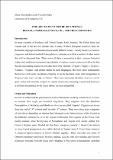Files in this item
Who are ‘oamenii nostri’ (our people) : Rudari, Lingurari, Băieshi, etc., and their identities
Item metadata
| dc.contributor.author | Popov, Veselin | |
| dc.contributor.author | Marushiakova-Popova, Elena Andreevna | |
| dc.contributor.editor | Sorescu-Marinkovic, Annemarie | |
| dc.contributor.editor | Kahl, Thede | |
| dc.contributor.editor | Sikimic, Biljana | |
| dc.date.accessioned | 2022-01-20T00:33:20Z | |
| dc.date.available | 2022-01-20T00:33:20Z | |
| dc.date.issued | 2021-01-20 | |
| dc.identifier | 257861188 | |
| dc.identifier | 9e036c51-401a-4b0e-9b96-e9a346207d5b | |
| dc.identifier.citation | Popov , V & Marushiakova-Popova , E A 2021 , Who are ‘oamenii nostri’ (our people) : Rudari, Lingurari, Băieshi, etc., and their identities . in A Sorescu-Marinkovic , T Kahl & B Sikimic (eds) , Boyash Studies : Researching "Our People" . Forum: Romänien , vol. 40 , Frank & Timme , Berlin , pp. 37-74 . | en |
| dc.identifier.isbn | 9783732906949 | |
| dc.identifier.other | ORCID: /0000-0001-5333-2330/work/85168398 | |
| dc.identifier.other | ORCID: /0000-0002-6565-8730/work/85168496 | |
| dc.identifier.uri | https://hdl.handle.net/10023/24714 | |
| dc.description.abstract | In Central, Southeastern and Eastern Europe, as well as in both parts of the American continent, there are Romanian-language communities known under different names – mainly Beash (in different phonetical versions); Rudari and Lingurari, as well as Karavlasi, Kopanari, Koritari and so on. What brings all these communities together is their common historical origin, their Romanian mother tongue, and above all the fact that their surrounding population considers them to be 'Gypsies' (‘Cikáni’, ‘Cigáni’, ‘Cyganie’, ‘Cigany’, ‘Țigani’, ‘Cigani’, ‘Цигани’, ‘Цыгане’ and other similar names in local languages). These communities themselves (with some exceptions, and over the last decades), however, firmly reject their designation as 'Gypsies' (and more recently also their earmarking 'Roma'). Their own identities can be quite varied and internally complex structured according different dimensions and built on several hierarchical levels (local, ethnic, national, and global). The article outlines the territorial distribution of all these communities, focusing on the diversity of their identities in the different countries of the world where they are living. Special attention is given to the processes of contemporary development of these identities, which have been influenced by two main factors over the last few decades. The first one is the rapidly growing interest in the "Roma topic" by different actors, and initiatives and actions conducted by the so-called Gypsy industry. The second factor are the mass migrations from the region of Central and Southeast Europe to the countries of Western Europe. On this basis, an answer is sought to the question whether or not it is possible to define them all as sub-divisions of one ethnic community and what kind of community they are, or whether it is about separate and detached communities who are still very far away from the stage defined by the concept of "imaginary community". | |
| dc.format.extent | 463034 | |
| dc.language.iso | eng | |
| dc.publisher | Frank & Timme | |
| dc.relation.ispartof | Boyash Studies | en |
| dc.relation.ispartofseries | Forum: Romänien | en |
| dc.title | Who are ‘oamenii nostri’ (our people) : Rudari, Lingurari, Băieshi, etc., and their identities | en |
| dc.type | Book item | en |
| dc.contributor.sponsor | European Research Council | en |
| dc.contributor.sponsor | European Research Council | en |
| dc.contributor.institution | University of St Andrews. School of History | en |
| dc.date.embargoedUntil | 2022-01-20 | |
| dc.identifier.url | https://www.frank-timme.de/verlag/verlagsprogramm/buch/suchbegriff/Boyash%20Studies/verlagsprogramm/bd-40-annemarie-sorescu-marinkovicthede-kahlbiljana-sikimic-eds-boyash-studies-researchin/backPID/suche.html?sword=Boyash%2520Studies | en |
| dc.identifier.grantnumber | 694656 | en |
| dc.identifier.grantnumber | 694656 | en |
This item appears in the following Collection(s)
Items in the St Andrews Research Repository are protected by copyright, with all rights reserved, unless otherwise indicated.

